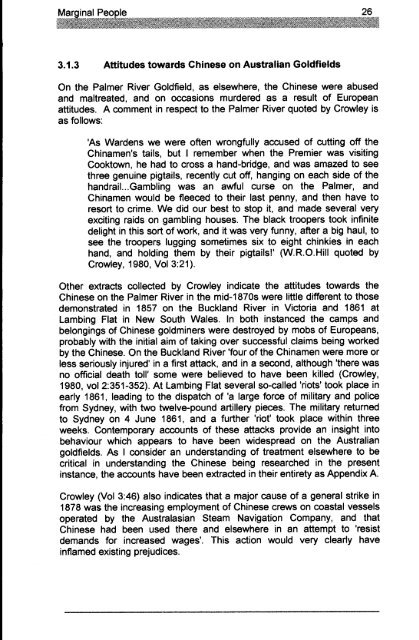Adec Preview Generated PDF File - The Sydney eScholarship ...
Adec Preview Generated PDF File - The Sydney eScholarship ...
Adec Preview Generated PDF File - The Sydney eScholarship ...
You also want an ePaper? Increase the reach of your titles
YUMPU automatically turns print PDFs into web optimized ePapers that Google loves.
3.1.3 Attitudes towards Chinese on Australian Goldfields<br />
On the Palmer River Goldfield, as elsewhere, the Chinese were abused<br />
and maltreated, and on occasions murdered as a result of European<br />
attitudes. A comment in respect to the Palmer River quoted by Crowley is<br />
as follows:<br />
'As Wardens we were often wrongfully accused of cutting off the<br />
Chinamen's tails, but I remember when the Premier was visiting<br />
Cooktown, he had to cross a hand-bridge, and was amazed to see<br />
three genuine pigtails, recently cut off, hanging on each side of the<br />
handrail...Gambling was an awful curse on the Palmer, and<br />
Chinamen would be fleeced to their last penny, and then have to<br />
resort to crime. We did our best to stop it, and made several very<br />
exciting raids on gambling houses. <strong>The</strong> black troopers took infinite<br />
delight in this sort of work, and it was very funny, after a big haul, to<br />
see the troopers lugging sometimes six to eight chinkies in each<br />
hand, and holding them by their pigtails!' (W.R.O.HiII quoted by<br />
Crowley, 1980, Vol 3:21).<br />
Other extracts collected by Crowley indicate the attitudes towards the<br />
Chinese on the Palmer River in the mid-1870s were little different to those<br />
demonstrated in 1857 on the Buckland River in Victoria and 1861 at<br />
Lambing Flat in New South Wales. In both instanced the camps and<br />
belongings of Chinese goldminers were destroyed by mobs of Europeans,<br />
probably with the initial aim of taking over successful claims being worked<br />
by the Chinese. On the Buckland River 'four of the Chinamen were more or<br />
less seriously injured' in a first attack, and in a second, although 'there was<br />
no official death toll' some were believed to have been killed (Crowley,<br />
1980, voI2:351-352). At Lambing Flat several so-called 'riots' took place in<br />
early 1861, leading to the dispatch of 'a large force of military and police<br />
from <strong>Sydney</strong>, with two twelve-pound artillery pieces. <strong>The</strong> military returned<br />
to <strong>Sydney</strong> on 4 June 1861, and a further 'riot' took place within three<br />
weeks. Contemporary accounts of these attacks provide an insight into<br />
behaviour which appears to have been widespread on the Australian<br />
goldfields. As I consider an understanding of treatment elsewhere to be<br />
critical in understanding the Chinese being researched in the present<br />
instance, the accounts have been extracted in their entirety as Appendix A.<br />
Crowley (Vol 3:46) also indicates that a major cause of a general strike in<br />
1878 was the increasing employment of Chinese crews on coastal vessels<br />
operated by the Australasian Steam Navigation Company, and that<br />
Chinese had been used there and elsewhere in an attempt to 'resist<br />
demands for increased wages'. This action would very clearly have<br />
inflamed existing prejudices.




